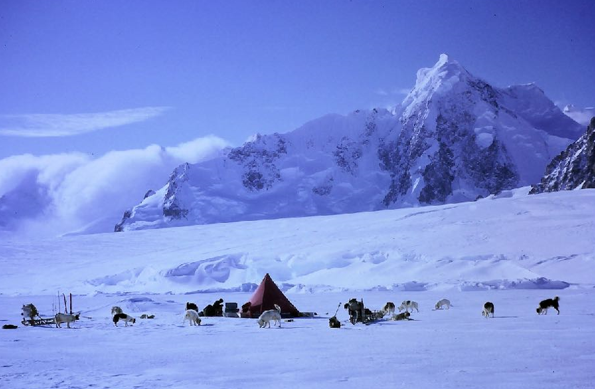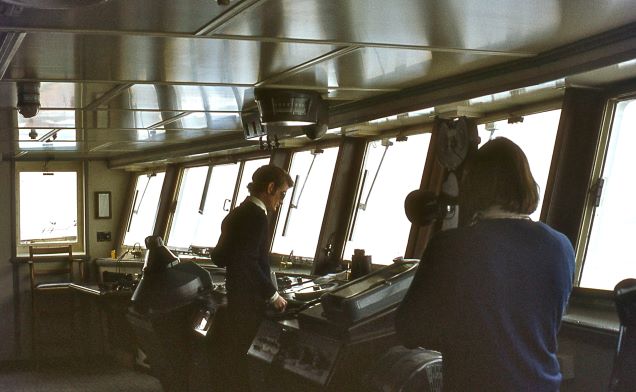Header – Stuart Lawrence conning the Bransfield
My first trip aboard Bransfield – Fourth Mate 1973/74 Season – Jack Tolson
All Photos by Jack Tolson unles otherwise stated
I first saw RRS Bransfield in Southampton docks one evening a few days before she sailed at the start of the 1972/73 season. It was a packed wardroom pre sailing party, and I was a guest of Third mate Ed Dewhurst. Ed and I had been apprentice deck officers together in British India Steam Navigation Company. BI, as it was universally known. BI was an integral part of the P&O Shipping group. However, during 1971 restructuring merged BI into the general cargo division of P&O. Small fish in a big pond syndrome forced Ed, me and many others to jump ship. Before we jumped I’d spotted an advert in a shipping magazine and told Ed about a fourth mate job with an interesting little company called BAS. He got the position. I hadn’t completed my seatime and therefore was not eligable to sit my second mate’s certificate in time.
Anyhow, by the following season they needed a new fourth mate and I applied.
Continued from Bransfield Page
I’m not certain the position was advertised as Ed kept me informed about potential vacancies and I kept myself local for any interviews. At this stage I was sailing as second mate aboard a fast reefer vessel carrying general cargo from UK to the Carribean and bananas back to Southampton.
I was aboard my ship ”Patuca” across the dock from Bransfield so a convenient interview took place with Captain Tom Woodfield. He interviewed me alone, there was no Eric Salmon or Bill Sloman present, neither of whom I’d yet heard about. The interview was held in his cabin, it was formal but relaxed. Tom asked me how much experience I had taking sights, cargo work and navigation. The predictable questions. I don’t recall him asking me any trick questions about Antarctica and what I might expect or whether I thought I’d be able to get along on a long voyage. I’d been used to very much longer voyages than our seven month Antarctic trips. I think he was surprised by the breadth of my experiences and the fact I was happy to drop rank significantly for this job. Anyhow, a few days later I was offered the position.
Husband’s shipyard, Marchwood -across the Solent- near the New Forest is where I joined Bransfield on 21st August, 1973. To say I was underwhelmed is an no exaggeration. The refit yard was scruffy, the ship was scruffy and this was the first time I appreciated just how small she was compared to my flying reefer boat, ‘Patuca’, American built in 1947. I was also shocked by the inactivity going on. I think every newcomer to BAS ships went through this experience in these days. Long drawn out idle time with a brief hiatus during the refit period when the ship was hung drawn and quartered, ripped apart before being reassembled, proclaimed ready for another Antarctic season. And so it was, although I remember having to go back into dry dock after sea trials for some repair to the variable pitch propeller before finally loading and sailing on the 31st October, 1973. Now, sailing was a bit of an experience with all these new people on board, not yet unkempt, colourful characters heading south. Some were seen off by parents or girlfriends, some had made the journey alone probably aware of the painful departure process ahead; something I was to learnt too. If it hurt for seven months well what about two and a half years. It sure hurt me waving goodbye to Jenny.
Now we were on our way and within a couple of days realised that this small ship really did leap around. She had an uncomfortable roll, she was what one called ‘stiff’, a lot of bottom weight to bring her back to the upright position, an attribute we’d all appreciate later on. I was seasick, how ashamed was I. Quite soon chief officer, the diminutive Stuart Lawrence, was called out when 45 gallon drums of petrol began to move around freely on deck. Bad situation.
Most FIDS, I’d learnt the term by now, were keeping a low profile, either desperately sea sick or unable to walk without colliding with flying tables and chairs. We headed off down towards the Azores and then swung almost westerly across the Atlantic for an American port Davisville. A new deal worked out by John Bawden enabled the American Palmer station, near the Argentine Islands, to be partially resupplied by Bransfield. The quid quo pro being free fuel for the ship, something the Americans were not short of.
In Davisville cargo was loaded chaotically…not that I recall much. Nick Beer and I went off touring and so did most of the FIDS. Eddie went in search of relatives and Stuart enjoyed cargo work on his own.
Night watches after Davisville were to become a lot more interesting as FIDS now took over from the crew as lookouts. This enabled the full complement of crew to work on deck by day, painting, tidying, splicing and preparing strops and other lifting gear for down south. FIDS too helped on deck and most enjoyed something about breaking the mind numbing boredom of just doing nothing. What made the night watches so interesting was being able to talk with a complete stranger about his expectations and motives about down south. One question I always asked was how it felt before putting pen to paper, to sign away two and a half years of your life. The response from the new FIDS was always the same. They had to think about it two, three or four times.

Despite the balmy, tropical weather I never enjoyed this intermediate part of the passage, wanting instead either to be down south or back home. Yet, it is what made it special for the FIDS. It was a period of time that moved their mind set away from university or cooking or tradesman in UK. This time began a process of inclusiveness, of understanding others and sharing and of course bonding. But it was only the start of the process. Any abject failures could still be weeded out at this early stage aboard ship. They were so few that we always wondered what Bill Sloman and Eric Salmon had to help guide them with their selection. Two very different characters skilled at getting the right man. Sorry, ladies, not yet.
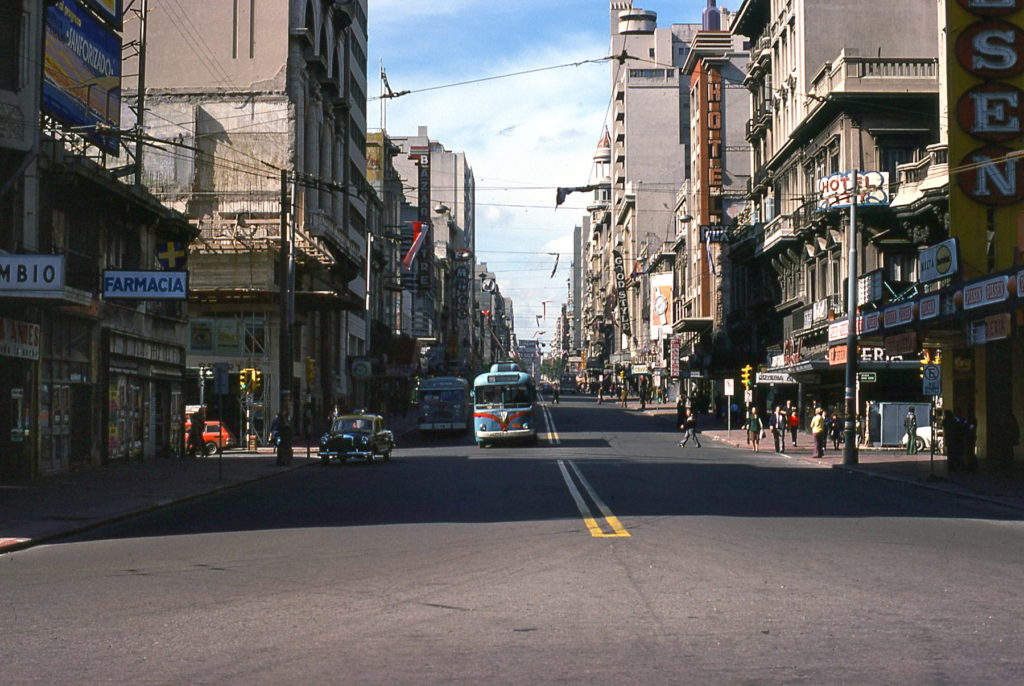
Captain Tom brought his wife Ella aboard for his final voyage and she really helped make it a big party these seven months. John K., chief engineer, had to be relieved half way through the trip and I was beginning to think I might follow suit for different reasons. No question about it but I was becoming mouthy towards a certain person, which was more a reflection of my frustration because by that time we hadn’t even hit south. Anyhow, I didn’t go.
We passed through Montevideo and its last opportunity for a good run ashore (and a few prayers for the next days after sailing) and then two days to Stanley to get that camera and lens at the duty free shop if Eric Heathorn hadn’t already made a sale.
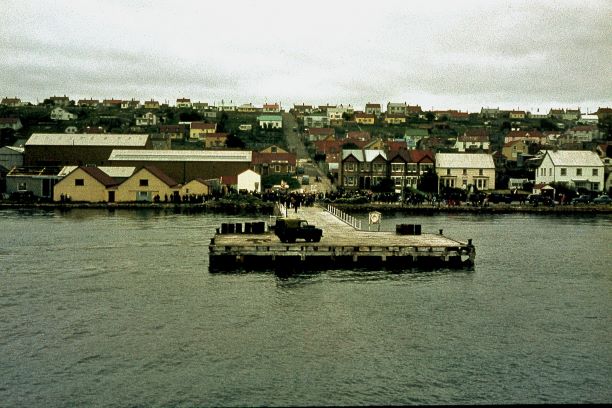
No flights yet from Stanley southward, so everyone sailed south, towards Anvers Island. Nobody really won the iceberg sweepstake. Every FID and new crew member scanned the evening horizon, now of course all daylight. Everyone gave up by 2300 but as the watchkeeper I ”saw” it on radar 24 miles away at 2347 hours, 15th December waking the FIDS with my own childish excitement. By sextant calculation it protruded 180 feet above the sea.
This was my first taste of Antarctica, massive high Alpine type mountains thrust upward with tiny Bransfield making her way around bergy bits and bergs; the ship’s engines reverberating against rock walls and the occasional crack of an avalanche in the far distance.
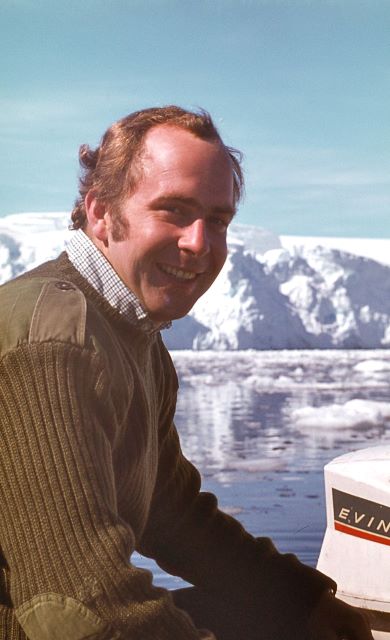
Nick Beer in the Gemini 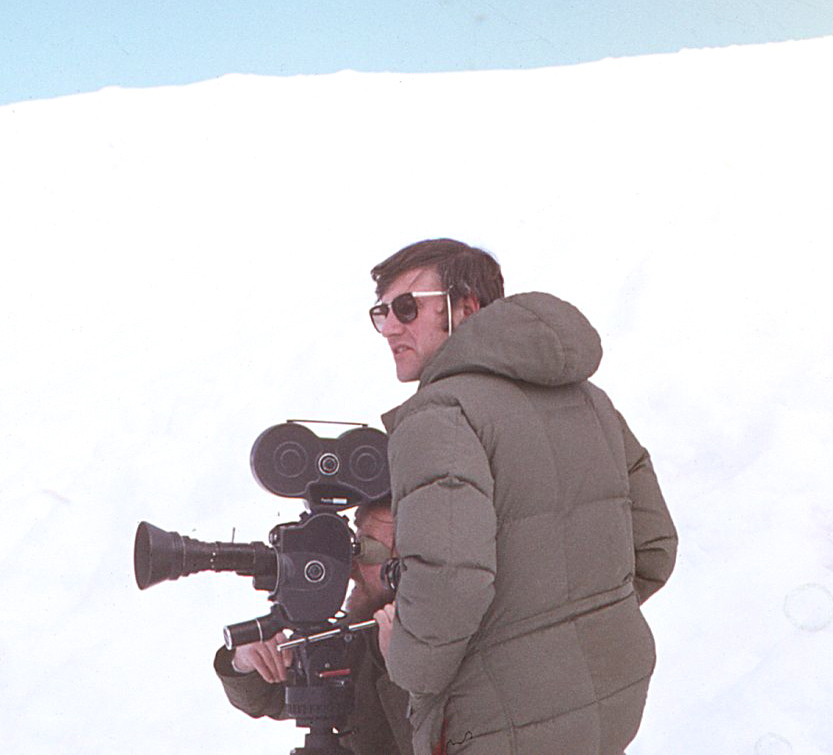
BBC Camerman 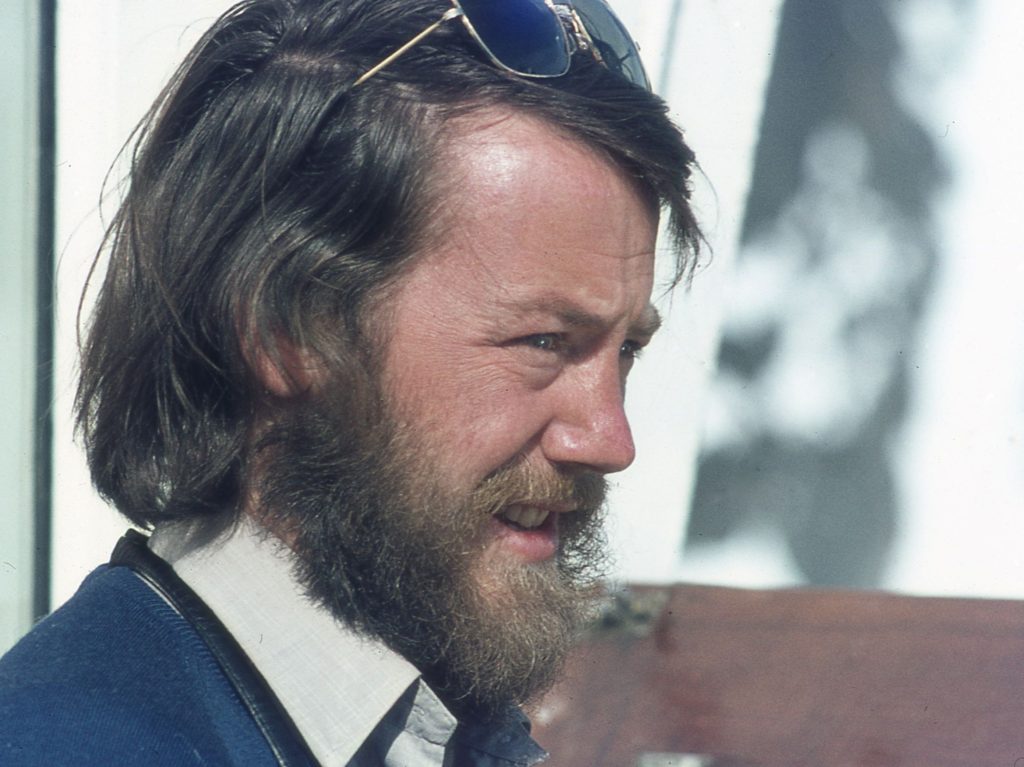
Edwin “Mick” Mickleburgh (Met – Signy 69, Adelaide 70) leading BBC Film Crew
Nick and I took the BBC four man film unit away by Gemini. This couldn’t have been more surreal for me as we sped down the Lemaire channel (Kodak Crack) looking for a suitable vantage point to land them for a shot of Bransfield passing down channel.
On Sunday 16th December we swung into the narrow Neumayer Channel leading to Doumer Island.
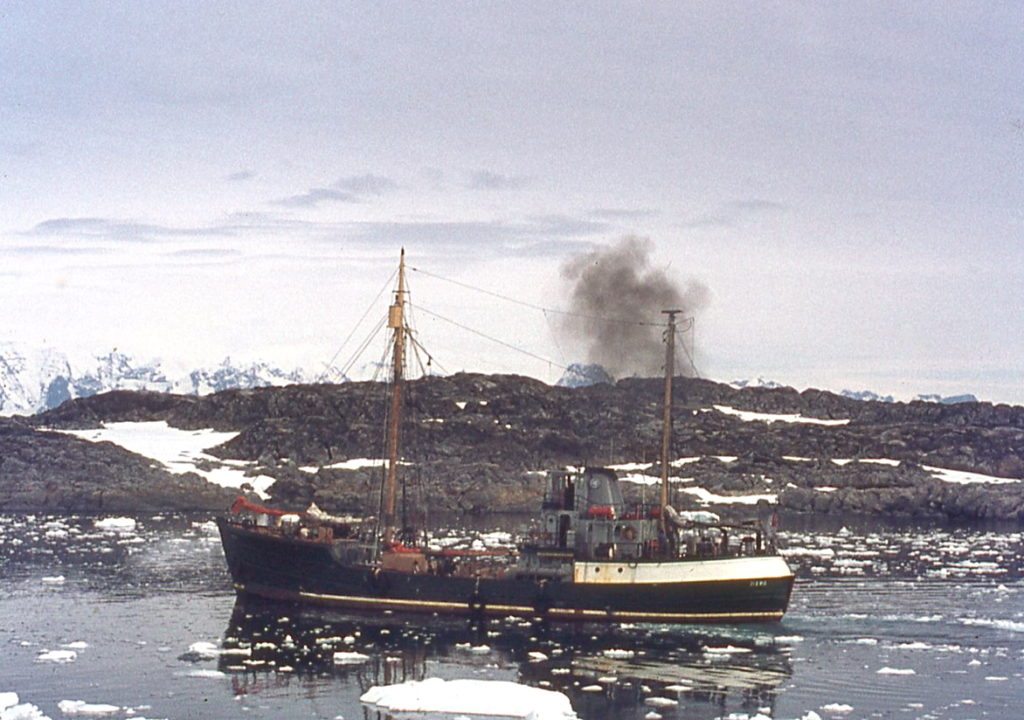
RV Hero arriving at Palmer Station 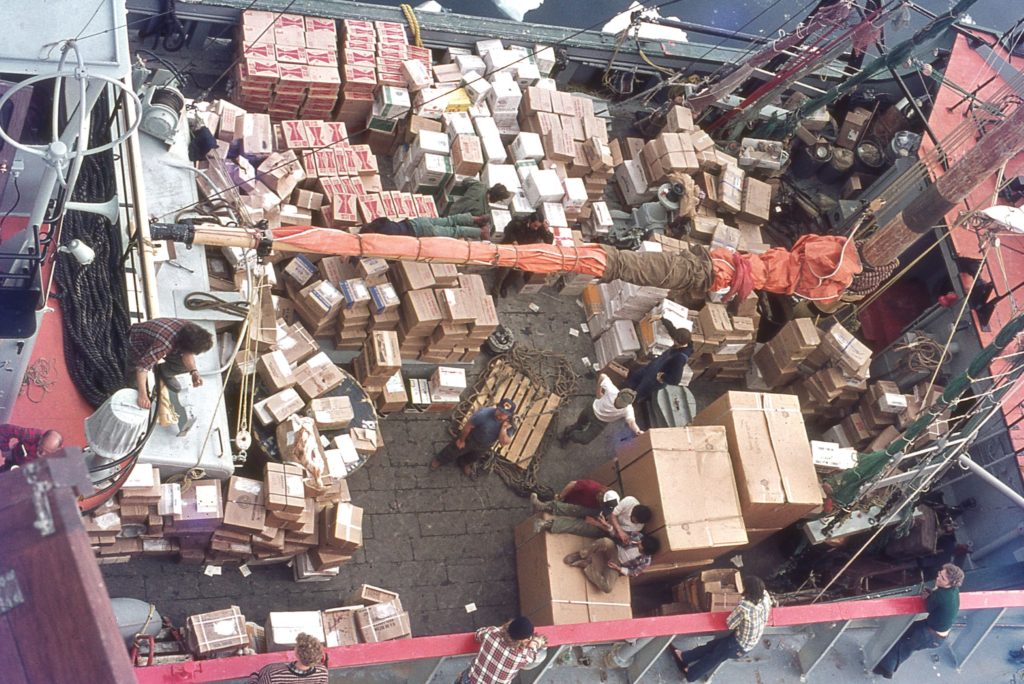
Hero’s cargo discharging from Bransfield
Completing Palmer and Argentine Island reliefs we make our way towards Adelaide passing down the western side of the island. It’s the longest day, the sun doesn’t set, bouncing magnificent orange, red and golden colour off the nearby bergs and bergy bits all around us. With a brief stop in the night we resume again at 0700 hours through 9/10 pack, making Adelaide by 0900 on 21st December.
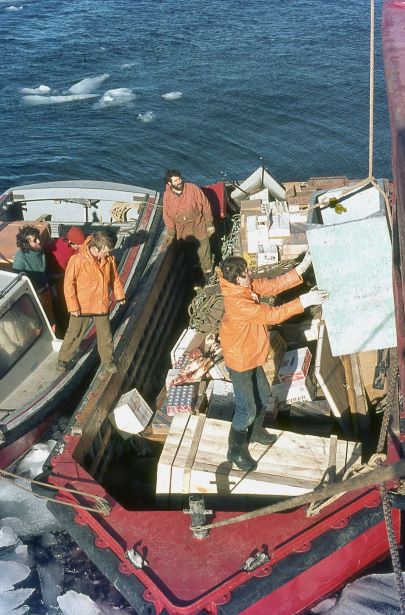
Stuart begins cargo work in glorious weather, I take a scow ride ashore and witness the perilous little jetty that gives such hell in anything but perfect conditions. I wander up the snow ramp to the 24 dogs and am warned if I speak with one of them then I’d have to talk to them all. I did and at the same time watched the ice slowly moving towards Bransfield in the distance. Above, the nimble clouds thickened and that night in 40 knot winds we dragged anchor.We spend Christmas day at anchor off Adelaide; the base happy to remain on base and our contingent of crew and FIDS making a very big party aboard. A vast photo opportunity took place on the helicopter deck in a wild blizzard. Stonington next and abnormally low spring tides complicated the small amount of cargo work there and at Argentine Islands we complete another small amount of cargo work.
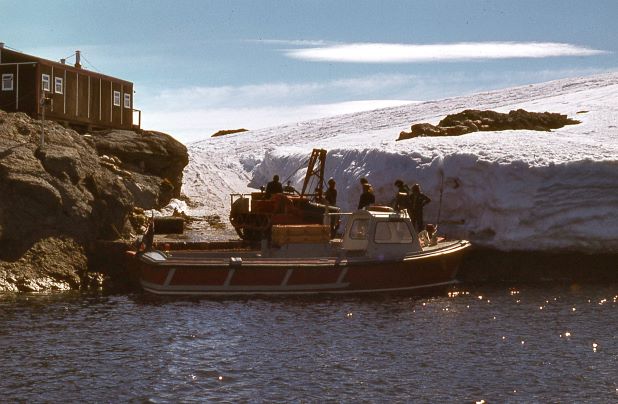
We’re bound for Punta Arenas now and New Years eve is approaching. Aboard ship is the Second secretary from the British embassy in Montevideo. He somehow got himself passage on the pretext of a bird watching trip. In misty weather we miss seeing Cape Horn 5 miles to our west and we creep slowly up to Tierra del Fuego. Here we have to take a pilot, not one but two as this waterway is claimed by both Chile and Argentina. The farce of it all doesn’t prevent us admiring the beautiful glaciers, the tree studded hill sides and massive walls of ice as we proceed slowly up the Beagle Channel.
Anchored by 2330 the celebration begins as we welcome in 1974. Fireworks by way of out of date pyrotechnics thread across the grey sky, the FIDS deck takes the brunt of the party. I take a hit as a Zorbas dance goes mad, bodies crashing to the deck, sliding on spilt beer. I get a huge cut above the left eye and our sober doctor asks if I need an injection before starting to stitch me up. Of course I don’t. Moments later the Second secretary is wheeled into the doctor’s surgery to be dealt with. He had made the inexcusable mistake of letting fire extinguishers off for the fun of it. His jaw met Robby’s fist. Well done, Robby the bosun.
In Punta Arenas Eddie and I take Larry Buchanan, the third engineer, on a Gemini joyride. The pretext is to test the engine, the real reason is to get photos of those magnificent decaying steel hulls of old sailing ships just off the coast. Stuart lowers us into the water from Bransfield and away we go. Ten minutes hard drive and birds scuttle away as we approach the wrecks. Their screeching ricochetting from hull to hull rising upward from our vulnerable position in the boat. We move about trying to get a good position but the birds are fleeing. Out of nowhere a crack followed by another and another. Now, the birds really do scream. Why use bird scarers here we wonder? Then we see the men on the beach. Three lying in the sand and a fourth standing, holding a small flag. Down goes the flag and bullets splatter the water around us two hundred yards off the beach. It’s hypnotic watching the water whip up and of course we wonder what to do. Who’s got a white handkerchief? No way, they’d get us on the way in. Slowly we creep towards a large steel buoy. The thick kelp stalling the engine every time. We row in and at this point realise the boat has been holed. Intent on getting away we line up the bow with the open sea, clear any trace of kelp and go straight out keeping the buoy between us and the men on the beach, who are still shooting. I’m driving and all I think about is keeping a straight course as I wonder what it’s going to feel like with a nice little bullet between the eyes.
As we reach Bransfield and are hauled aboard Stuart comments that ”Where you lads have just been you were lucky not to have been shot at” Later that evening we learn the Governors palace had been attacked by Marxist rebels.The second half of the trip was an anticlimax by comparison.
In later seasons I sail as second mate with Stuart as Master. He’s a refreshing character whose constant wit and guile keeps all aboard on their toes.
John “Jack” Tolson, RRS Bransfield & RRS John Biscoe, 1973 to 1979
